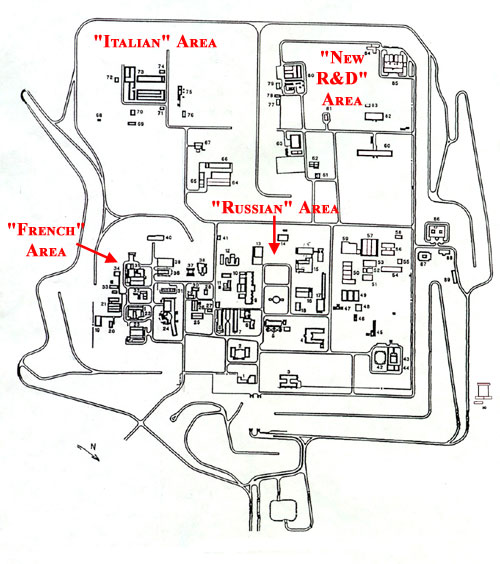

Dimitri Perricos1: Now, I want to show you an overhead picture and a schematic of Tuwaitha. I want to show it to you, because it was only before the first inspection that the IAEA saw an overhead picture of the whole site. It was the first time that the IAEA was able to see the magnitude of the site it was visiting before the Gulf War. The picture and the schematic were used to brief the first inspection team.
The Iraqis had constructed big berms, about 30 meters high, around the site. On top, they had anti-aircraft guns because, of course, of the Israeli bombing of the Tamuz reactor and for the defense of the site from Iranian aircraft. But at the same time, the berms were able to hide areas of the site from eyes of visitors, including safeguards inspectors.
Most of the EMIS activities and the production of the initial target material was done in so-called "new R&D area" [points to image on schematic]. Analysts had named areas of the site, based on the country that had provided som basic technology to Iraq. So, [points to image] we have the "Italian area" were, where there were fuel fabrication and other laboratories; there was the "French area," [points to image] where the French reactor Tamuz was located, and there was the "Russian area" in the center [points to image] where the old IRT research reactor was located.
Of course, there were other areas where you had the waste disposal and other activities. These were mixed: part French and part Italian, for the hot cells, and parts of it from the USSR. The "new development area," [points to image] where most of the R&D work was done, was secluded.
Source: Excerpt from "Uncovering the Secret Progam -- Initial Inspections," presentation by Dimitri Perricos, Former Deputy Leader of the IAEA Action Team, at the conferece "Understanding the Lessons of Nuclear Inspections and Monitoring in Iraq: A Ten-Year Review," sponsored by the Institute for Science and International Security, Washington, DC June 14-15, 2001. [Back to the top]